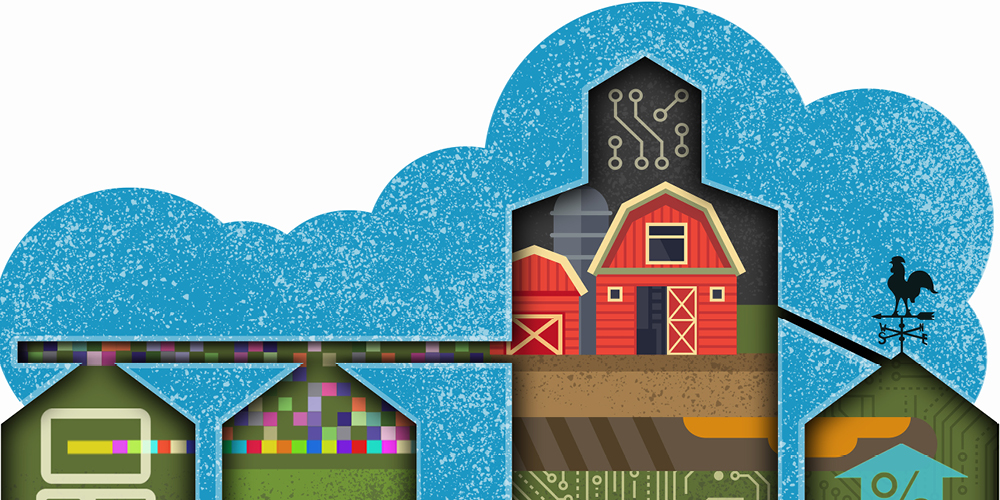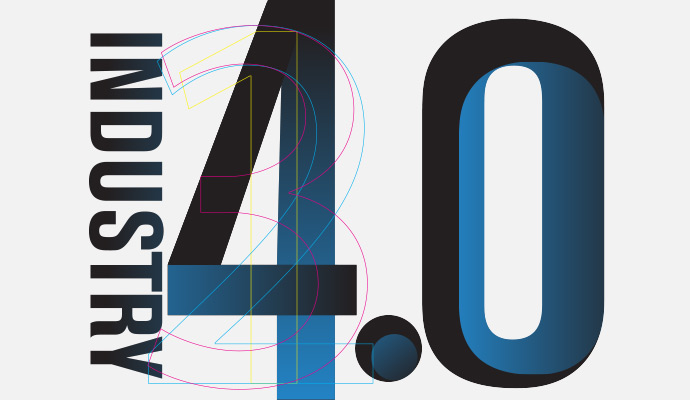The fourth industrial revolution in agriculture
For agribusinesses, implementing new technologies requires focusing on four critical capabilities.
A version of this article appeared in the Spring 2020 issue of strategy+business.
Do all cows’ faces look the same to you? They don’t to systems powered by artificial intelligence (AI). Bovine facial recognition technology, developed through a strategic partnership between Cargill and an Irish technology company called Cainthus, equips barns and fields with smart cameras that can identify each cow in a herd in seconds based on facial features and hide patterns. Linked to machine learning software, the system determines whether a cow isn’t eating or drinking enough, or if she’s sick, and can alert the farmer via smartphone app. It can also look at the whole herd’s behavior to identify how best to distribute feed or schedule cows’ stints in a specific pen or in the field. Over time, the platform learns from what it sees and begins to automate more of the daily care for each animal.
The fourth industrial revolution (4IR) is starting to change how every agricultural player, from a family farmer to a global conglomerate, produces food and related products. The spread of the so-called essential eight technologies — such as AI, blockchain, drones, and the Internet of Things (IoT) — to agriculture is leading to increased yields, lower costs, and reduced environmental impact. These tools are also empowering farms to unlock new plant-based innovations and increasing their resilience to extreme weather events and climate change.
Significant money is at stake. In 2018, agritech startups raised US$16.9 billion, a 43 percent increase over the year before. As compatible technology and high-speed wireless networks spread more quickly — telecom operators are planning to invest as much as $1 trillion on 5G infrastructure by 2025 — the adoption of agriculture-related technology will accelerate.
However, this revolution in agriculture imposes new demands on producers and the organizations that serve them. To thrive in 2030 and beyond, agricultural companies must choose carefully among the new technologies, to avoid wasting time and money or — worse — missing out on critical opportunities. Many companies will also need to change how they organize themselves and their business lines to best use these technologies.
The right approach to all these challenges requires that companies define their place in the digitized world of agriculture, then identify and develop the right capabilities system to succeed in it.
The future of farming
We cannot know exactly how the world will look in 2030, but existing megatrends indicate the likelihood of more people, more of whom will live in cities; more extreme weather shocks and natural disasters; greater pressure on fresh water, arable land, and other natural resources; and overfished, overheating, and rising oceans. That may sound bleak, but with the right approach, agriculture companies can feed this near-future planet better than ever, while reducing pressure on resources.
A tremendous variety of technologies are currently in development. One Brazilian company, for example, offers a system that uses drones and IoT sensors to gather data on pigs and their environment. It enables swine farmers to enter further information, such as the pigs’ weight or births, into the system by simply speaking into their phones. Analytics, synchronized across a swine farmer’s entire operation, provide visuals on every stage of production. Farmers can share the information with suppliers of feed and medicines, or establish key performance indicators for supervisors and managers. Other companies have similar solutions on the market for other types of livestock.
Some 4IR agriculture technologies seem to come straight out of science fiction. One firm is developing a swarm of miniature autonomous robots that can plant seeds. Controlled by a farmer’s handheld tablet, which is operated with the help of satellites and cloud-based software, the swarm will be able to put each seed in the right place with greater precision than current approaches can. Not incidentally, the technology will eliminate the need for planter bars, tractors, and tractor operators. Because the swarm can adjust seed locations for changing conditions, it will increase yield, with lower costs, faster planting speeds, and a reduced impact on the environment.
So many new technologies, products, and services are appearing that the entire sector will soon be unrecognizable to participants of a generation ago. To prepare for this future, agricultural companies must take the right steps right now.
Don’t simply digitize
The most common response of companies has been to plug new technology into old business models, with the hope of enhancing those models with smarter tools and more data. But that tactic is flawed. Making old models work better isn’t enough — not when technologies are enabling all-new models that can render the old ones obsolete.
So many new technologies, products, and services are appearing that the entire agricultural sector will soon be unrecognizable to participants of a generation ago. To prepare for this future, agricultural companies must take the right steps right now.
Many pesticide and fertilizer companies, for example, are using 4IR technologies to provide better products and roll them out faster than before. That might sound like a success story, but precision farming — which uses IoT sensors, high-resolution 3D aerial imagery from drones, and AI-powered analytics to analyze the characteristics of soil and the behavior of crops down to the square inch — may soon significantly reduce the need for fertilizers and pesticides altogether.
A better approach for those manufacturing companies is to discover and develop these new business models, creating new markets along the way. Instead of looking for a better product, companies should look for better solutions for the problems that their customers face, whether those customers are farmers, agricultural suppliers, or end consumers. Many successful solutions will bring together products and services from multiple companies, rather than just using products manufactured by the solution provider.
To determine which solutions to offer and how to offer them, companies need to fully understand their current competitive position, including its strengths and vulnerabilities. Leaders can then determine where they want to compete in the agriculture ecosystem of the future. In whichever competitive position they choose, they will need the right capabilities to win. Organic innovation, joint ventures, incubators, and acquisitions should all be considered to get an organization learning and evolving.
Companies will need many different capabilities, depending on their chosen competitive position. But for nearly every agricultural player, four capabilities will serve as a foundation of success.
Generating a “so what” from data through digitized operations and advanced analytics
Digitization is perhaps the clearest example of how 4IR technologies can, and should, go beyond simply making traditional business models work better. Such technologies are leading an all-new agriculture value chain, with digital businesses at each link of that chain tapping into new revenue streams.
These forward-looking agricultural companies don’t just capture and harness data. They help clients figure out what data they need and how they will get it; they also help standardize and analyze data to recognize patterns and formulate recommendations. In other words, they generate a “so what” from the reams of data in which so many organizations are currently drowning.
In practice, producing this “so what” usually means applying analytics in order to operate equipment more efficiently; determine more accurate feed formulations; manage animal well-being; create marketplaces; and better manage logistics, pricing, customer performance, and more.
John Deere, for example, is increasingly selling data management services in addition to farm equipment. The company’s Operations Center system enables farmers to collect data from equipment (whether or not that equipment was manufactured by Deere), see and analyze that data on dashboards, share data with partners (including a suite of third-party, software-as-a-service providers), and operate machines remotely.
For Deere and other companies like it, data analytics is no longer a cost center, targeted for cuts. It is a strategic capability that can create new business models.
Participating in — and leading — new collaboration ecosystems
It’s impossible for any single company to gather, manage, develop, and use all the sources of data and all the new technologies that emerging agricultural business models depend on. The autonomous superfarms and biofactories that may soon provide much of humanity’s food? Those will require multiple stakeholders, from conglomerates to startups to farmers in the field, working together.
Leading agricultural companies will be skilled at partnering with other companies, large and small, and with universities and other sources of innovation to identify trends and capitalize on external knowledge. They will be “extroverted,” outward-looking organizations, with the vision to orchestrate new agriculture ecosystems. And they’ll use mergers and acquisitions to fill gaps in 4IR-based business models.
Collaboration should always be grounded in a company’s objective assessment of its own strengths and where it will be better off capitalizing on the strengths of an external partner. For example, one company may be strong in food processing but need partners for food formulation insights. Another may have exciting R&D but need partners to get its inventions into the marketplace. The key is to understand one’s role in the agricultural value chain of tomorrow, then build the partnerships and make the deals to strengthen that role.
Consider how McDonald’s (at the end of the agriculture value chain) recently acquired an Israeli AI startup called Dynamic Yield, which has strong capabilities in using analytics to personalize customer options. McDonald’s will use the new asset’s tools to vary digital drive-through menus based on the time of day, the weather, how busy the restaurant is, and trending menu items. When a customer places an order, the AI system will instantly suggest other items to complement it. Using the data it gathers, the system will improve its own performance over time.
Innovating business models based on core strengths
Every company, inside and outside agriculture, wants to be more innovative. But the winners will be those that base their efforts on a sound understanding of their existing corporate strengths and culture.
Cargill, for example, helped to develop an open source blockchain solution to provide reusable digital tools for supply chain use cases, including food safety and traceability. Because the system is open source, it does not exclusively sell Cargill’s products. But the company is putting itself in the middle of global innovation, connecting with potential suppliers and clients, and giving itself the potential to help shape blockchain to its benefit.
Whatever their specialty, agricultural companies will need procedures to systematically screen, evaluate, and prioritize emerging technologies. They will also need cross-functional collaboration to better identify and more quickly develop and implement the best ideas; internal R&D and technology units capable of rapidly building pilots; and an agile approach to get the most promising ideas into the market quickly, based on continuous feedback loops that take advantage of real-world customer input. It’s critical for companies to test a wide array of solutions, “fail fast” on less-promising ideas, and reallocate capital and other resources to the winners.
Monetizing the business opportunities from sustainability
Sustainability isn’t just a good idea. It’s also one of the largest profit opportunities for the agricultural sector. A U.N.-backed study put the potential value of business opportunities related to food and sustainability at $2.3 trillion by 2030.
Such opportunities go far beyond marketing. They’re based on reducing food waste; reformulating products and packaging; developing new fertilizers and more precise ways to improve plant characteristics; managing farms, forests, and oceans with a smaller footprint; promoting micro-irrigation; and increasing composting and energy capture, for example.
To succeed with these and other opportunities, companies must understand the societal expectations, ecological changes, and technological advances behind them. They must be able to quantify the sustainability of their products and activities and integrate sustainability in all their investment and business decisions.
Coca-Cola and Unilever, for example, have both set ambitious and measurable sustainability goals: Coca-Cola will collect and recycle the equivalent of every bottle or can it sells globally by 2030, and Unilever will reduce its environmental footprint (as quantified in sectors such as greenhouse gases, water use, and packaging) by half, also by 2030. Quantifying targets in this way requires integrating nonfinancial metrics into business models and long-range strategic planning.
Notably, sustainability requires all three of the other foundational capabilities: top-notch data and analytics, collaboration across the value chain, and in-house innovation.
How to get started
Preparing for a new world is a daunting task, but many agricultural companies — as well as the technology, industrial, and logistics companies they work with — are already moving quickly.
Whether a company is in the midst of a full-on effort to implement 4IR solutions, or is just beginning to understand the need, four steps can help set a company on the right path, course-correct along the way, and arrive quickly at the desired future state.
Start by finding your place in the future 4IR agriculture ecosystem: the spot where you will be best able to compete and win.
Next, assess your current gaps in the four key capabilities we’ve described and other more sector-specific capabilities.
Once you’ve identified the opportunities, set a path to close those gaps as needed to win in your future ecosystem role, with a specific investment agenda, whether through organic growth, joint ventures, or tuck-in acquisitions.
Finally, you’ll also need to evolve the culture, building on existing strengths where possible, to align the entire organization around the new and better capabilities.
By choosing the right place to compete in the agricultural ecosystem of the future — and building the right capabilities to win — agricultural leaders can keep growing into 2030 and beyond, all while helping to feed and sustain the world’s communities.
Author profiles:
- Sebastiaan Nijhuis is a leading practitioner working in PwC’s U.S. agribusiness advisory group. Based in Minneapolis, he is a director with PwC US.
- Iris Herrmann is an advisor to executives in the chemicals industry for Strategy&, PwC’s strategy consulting group. Based in Munich, she is a partner with PwC Strategy& Germany.





